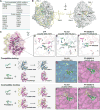Structure of the Human cGAS-DNA Complex Reveals Enhanced Control of Immune Surveillance
- PMID: 30007416
- PMCID: PMC6084792
- DOI: 10.1016/j.cell.2018.06.026
Structure of the Human cGAS-DNA Complex Reveals Enhanced Control of Immune Surveillance
Abstract
Cyclic GMP-AMP synthase (cGAS) recognition of cytosolic DNA is critical for immune responses to pathogen replication, cellular stress, and cancer. Existing structures of the mouse cGAS-DNA complex provide a model for enzyme activation but do not explain why human cGAS exhibits severely reduced levels of cyclic GMP-AMP (cGAMP) synthesis compared to other mammals. Here, we discover that enhanced DNA-length specificity restrains human cGAS activation. Using reconstitution of cGAMP signaling in bacteria, we mapped the determinant of human cGAS regulation to two amino acid substitutions in the DNA-binding surface. Human-specific substitutions are necessary and sufficient to direct preferential detection of long DNA. Crystal structures reveal why removal of human substitutions relaxes DNA-length specificity and explain how human-specific DNA interactions favor cGAS oligomerization. These results define how DNA-sensing in humans adapted for enhanced specificity and provide a model of the active human cGAS-DNA complex to enable structure-guided design of cGAS therapeutics.
Keywords: STING; cGAS; innate immunity; structural biology.
Copyright © 2018 Elsevier Inc. All rights reserved.
Conflict of interest statement
The Dana-Farber Cancer Institute and Harvard Medical School have patents pending for human cGAS technologies on which the authors are inventors.
Figures







Comment in
-
Human cGAS Has a Slightly Different Taste for dsDNA.Immunity. 2018 Aug 21;49(2):206-208. doi: 10.1016/j.immuni.2018.08.005. Immunity. 2018. PMID: 30134199
References
-
- Andreeva L, Hiller B, Kostrewa D, Lassig C, de Oliveira Mann CC, Jan Drexler D, Maiser A, Gaidt M, Leonhardt H, Hornung V, et al. cGAS senses long and HMGB/TFAM-bound U-turn DNA by forming protein-DNA ladders. Nature. 2017;549:394–398. - PubMed
Publication types
MeSH terms
Substances
Grants and funding
LinkOut - more resources
Full Text Sources
Other Literature Sources
Molecular Biology Databases
Research Materials

